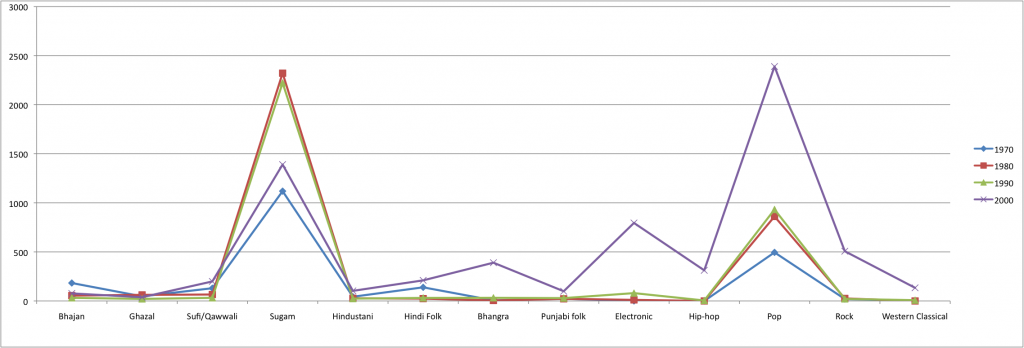The title of this post is a direct quote from an interview with Shubha Mudgal. Many months ago, I made a similar observation is a post titled Is Bollywood Overdose Killing India Music?.
There is no denying the fact that Bollywood music’s overwhelming popularity suppresses non-film music. But isn’t Bollywood itself a melting pot of many genres? How then could we lose Indian genres to Bollywood?
To answer this question, I tried to find out how Bollywood has used non-filmi genres over the years and understand if there is a decline in the usage of these genres. With Thej’s help, I put together this chart from MySwar data:
x-axis: Genres, y-axis: Number of songs
Here is my interpretation of this data:
- Sugam sangeet is a big part of Bollywood. Sugam (or Geet or light classical music) has always been a big part of Bollywood and continues to be. As long as this continues, Bollywood will continue to promote Indian classical music forms (albeit indirectly).
- But is threatened by the Western music juggernaut. Western musical forms have always influenced Bollywood but the growth of this influence of the 2000s has been mind-boggling. The 2000s represent the first decade in which Pop music influenced a greater number of Bollywood songs that Sugam music did. In fact Western musical forms (Electronic, Hip-hop, Pop, Rock, Western Classical) influenced almost 50% of the songs made in Bollywood in the 2000s!
- Indian genres can’t beat Bollywood but they can join Bollywood. Folk music has always been a relatively insignificant influence on Bollywood music. However, over the last decade Bhangra and other Punjabi folk music has taken Bollywood by storm. My take is that Bollywood adopted Punjabi folk music with gusto when the likes of Daler Mehndi popularized the genre by producing a series of successful albums.
My conclusion from this analysis is that things indeed don’t look very good for non-filmi Indian genres. But the analysis also points that the solution to this problem lies outside the film industry. The rise of Punjabi folk music and Western music in Bollywood is not incidental. Bollywood films are commercial ventures and they produce music they think people want to listen to and right now they think people like Bhangra, Pop, Electronic, Hip-hop and Rock. Indian musical genres must find ways of making themselves popular independently before Bollywood embraces them.


